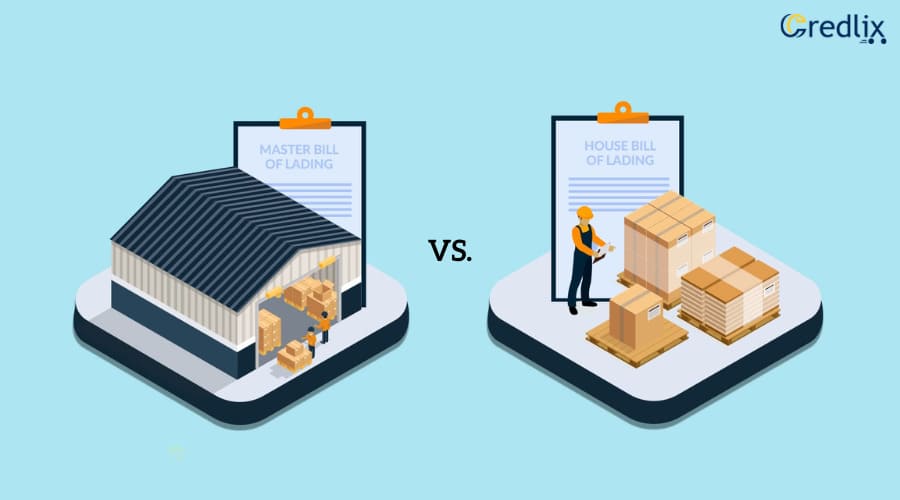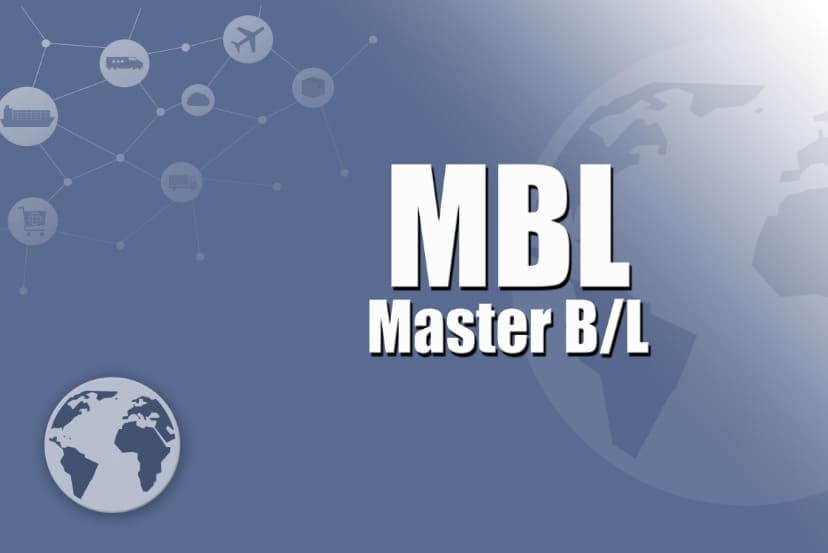If you work in shipping or logistics, you’ve probably heard about “master bill of lading” and “house bill of lading.” These terms might sound a bit complicated, but they’re like special papers that help keep track of things when they’re shipped. You must be aware of these terms, but do you know how they differ?
Understanding the difference can be a bit tricky. Before we explore what makes these two types of bills different, let’s first understand what a bill of lading and a master bill of lading is. After that, let’s break down these differences in simple terms and get a clear picture!

What is a House Bill of Lading?
A House Bill of Lading is a document used in shipping and logistics to outline details about a specific shipment. It’s like a special receipt that focuses on particular items within a larger shipment.
While a Master Bill of Lading covers the entire shipment, the House Bill breaks it down, specifying what’s inside and who it’s going to. It helps in tracking and managing goods during transit, providing clarity on the contents for everyone involved in the shipping process.
So, think of the House Bill of Lading as a detailed guide that ensures the right things reach the right places.
Also Read: House Bill of Lading | Meaning, Format & More
What is a Master Bill of Lading?
A Master Bill of Lading is a crucial document in shipping and logistics. It’s like the big boss of all shipping papers. This document covers the entire shipment, providing an overview of what’s being transported, where it’s going, and who’s involved.
Unlike a House Bill of Lading, which focuses on specific items in a shipment, the Master Bill looks at the bigger picture. It helps coordinate the entire shipping process and is often issued by the main carrier or freight forwarder.
In simple terms, it’s the top-level document that guides the transportation of goods from one place to another.
Also Read: What is A Master Bill of Lading? Meaning, Requirements and Example
Difference Between House Bill of Lading and Master Bill of Lading
Understanding these differences is crucial for participants in the shipping and logistics industry to ensure smooth and efficient cargo transportation.
Issuing Entity
- HBL: This document is usually issued by a freight forwarder, consolidator, or Non-Vessel Operating Common Carrier (NVOCC). These entities gather shipments from multiple shippers, consolidate them, and then issue individual HBLs for each part of the consolidated cargo.
- MBL: The Master Bill of Lading is issued by the primary carrier or shipping line responsible for transporting the entire consolidated shipment. It serves as the overarching document encompassing all individual shipments.
Scope
- HBL: It functions as a standalone contract, focusing on the particulars of a specific part or parts within a consolidated shipment. The HBL encapsulates the terms of agreement between the issuer and the shipper or consignee for that particular segment of the cargo.
- MBL: This document has a broader scope, covering the entire consolidated shipment. It establishes the primary contractual relationship between the main carrier and the shipper, outlining the terms for the entirety of the cargo.
Consolidation
- HBL: Each HBL represents a distinct part or parts of the consolidated cargo. Multiple HBLs can exist within a single consolidated shipment.
- MBL: It consolidates all individual HBLs issued for different segments of the shipment into a master document, providing a unified overview.
Contractual Relationship
- HBL: The House Bill establishes a contractual relationship between the issuer (freight forwarder/NVOCC) and the shipper or consignee. It outlines the terms specific to the part of the cargo covered by that HBL.
- MBL: The Master Bill forms the primary contract between the main carrier and the shipper, encompassing all segments of the consolidated shipment.
Responsibility
- HBL: Responsibility for the specific part of the cargo covered by the HBL rests with the entity that issued it. This includes overseeing the transportation, delivery, and compliance with the agreed-upon terms.
- MBL: The main carrier assumes responsibility for the entire consolidated shipment, ensuring the safe and timely delivery of all parts covered by various HBLs.
Delivery Authority
- HBL: The HBL grants authority to release specific goods to the consignee mentioned in the document, pertaining only to the part of the cargo covered by that particular HBL.
- MBL: The Master Bill provides the authority to release the entire consolidated shipment to the consignee named in the MBL, giving access to all parts covered by various HBLs.
Visibility
- HBL: Limited in scope, offering details only for the specific part of the cargo covered by the HBL. It provides a detailed view of the goods associated with that particular bill.
- MBL: Comprehensive in nature, providing a consolidated and holistic view of the entire shipment. It offers insight into all parts covered by different HBLs.
Amendments
- HBL: Amendments to the HBL can be made independently, allowing for modifications specific to the part of the cargo covered by that particular HBL. Changes may include adjustments to quantities, destinations, or other relevant details.
- MBL: Amendments typically involve the entire consolidated shipment and may impact multiple HBLs. This could include changes to the overall routing, scheduling, or other global aspects of the shipment.
Negotiability
- HBL: The negotiability of the HBL depends on the terms specified in the document. It can be negotiable or non-negotiable, influencing the ease with which it can be transferred or assigned.
- MBL: Generally, the Master Bill is non-negotiable, as it serves as the primary contract between the main carrier and the shipper. Negotiability is less common due to the complexity of dealing with the entirety of the consolidated shipment.
Destination Control
- HBL: Provides control over the destination of the specific part of the cargo mentioned in the HBL. The consignee has authority over the goods associated with that bill.
- MBL: Determines the final destination of the entire consolidated shipment. It influences the overall routing and delivery of all parts covered by different HBLs, providing a global perspective on the cargo’s journey.
Similarities Between House Bill of Lading and Master Bill of Lading
While a House Bill of Lading (HBL) and a Master Bill of Lading (MBL) serve distinct roles in the shipping and logistics process, they share several similarities:
Legal Documents
Both the HBL and MBL are legally binding documents that serve as evidence of the contract between the carrier and the shipper or the issuing entity.
Transportation Agreement
Both bills of lading serve as transportation agreements, outlining the terms and conditions under which the goods will be transported from the origin to the destination.
Receipt of Goods
Both documents acknowledge the receipt of goods for shipment. They confirm that the carrier has taken possession of the cargo and is responsible for its safe transport.
Identification of Parties
Both bills of lading identify the parties involved in the shipment, including the shipper, consignee, and carrier. This information helps in tracking and ensuring the correct delivery of goods.
Description of Goods
Both bills of lading provide a description of the goods being transported. This includes details such as quantity, weight, dimensions, and any special markings or handling instructions.
Terms and Conditions
Both documents specify the terms and conditions of the transportation, including responsibilities, liabilities, and any special requirements related to the handling of the cargo.
Title of Goods
Both bills of lading may include provisions related to the transfer of the title of the goods from the shipper to the consignee upon certain conditions being met.
Issuance by Carrier
Both the HBL and MBL are typically issued by carriers, whether it’s the main carrier issuing the MBL or a freight forwarder/NVOCC issuing the HBL.
Cargo Tracking
Both bills of lading play a crucial role in cargo tracking. They provide reference numbers and information necessary for tracking the movement of the goods throughout the shipping process.
Importance in Trade Finance
Both documents are essential in trade finance, often used to facilitate transactions, secure financing, and ensure compliance with international trade regulations.
Final Words
In conclusion, mastering the distinctions between a House Bill of Lading (HBL) and a Master Bill of Lading (MBL) is like having a roadmap in the world of shipping. Picture the HBL as a detailed guide for specific items, ensuring they reach their intended destinations, while the MBL acts as the captain, steering the entire ship.
Despite their unique roles, both share common ground as vital documents in the shipping journey—legal receipts, transportation agreements, and keys to tracking cargo. Whether you’re a shipper, consignee, or logistics enthusiast, understanding these nuances is pivotal, ensuring a smooth sail in the intricate seas of global trade.





